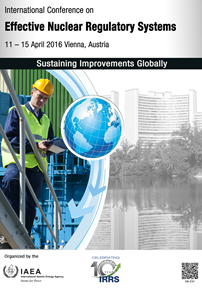You have been invited to submit a paper to be included in an IAEA conference proccedings publication. IAEA publications have a specific style and to help you prepare your article in the appropriate format we have provided some support information.
The file ‘example paper.docx’ available on the conference website demonstrates how your paper should be formatted for submission to the IAEA conference proceedings. The text of the example paper explains and demonstrates the formatting needed and gives all required fonts and font sizes. Alternatively, applying the styles saved in this document to your text paragraph by paragraph should format it correctly. Your word processing software may also contain a tool such as a ‘format painter’ that will enable you to copy the formatting from the example text to your own text, if you prefer to reformat an existing file.
Please note care should be taken when cutting and pasting as it can change the formatting. Please choose the paste option ‘Keep text only’ (and not ‘Keep source formatting’.)
Copyright and permissions account for some of the most frequently asked questions about conference proceedings. To help address this we have produced a summary of some of the most common mistakes and how to avoid them (below).
If you have any feedback on the support documentation, suggestions for ways to improve it or ideas for additional information that would be useful, please do contact MTCD.Advance-Publishing-Advice@iaea.org
Authors are asked to transfer copyright to the IAEA. This enables the IAEA to publish the work in multiple formats and grant permissions for re-use, and ensures that we have the rights to disseminate the work. Authors should check that they have the right to transfer that permission to the IAEA. Reasons why this may not be the case:
Plagiarism may also occur accidentally when text is copied from a web site for research purposes without marking its source in any way, and the author later incorporates it into the document without realizing that it is not his or her work. For this reason it is important to keep research material separate from the text of a paper in progress.
If you submit your paper for inclusion in a conference proceedings, and it is found to contain unoriginal text or to reuse figures without the correct permission, only the abstract of the paper will be included in the proceedings, and the paper author may not be notified of this before publication.
Copyright and permissions — Tips to avoid common mistakes
The IAEA asks authors to transfer copyright to enable us to publish and disseminate the work in the future. The IAEA also routinely scans manuscripts to check for duplicate publication; such scans are now standard in publishing and are implemented by the majority of publishers in scientific and technical areas.
Authors are asked to transfer copyright to the IAEA. This enables the IAEA to publish the work in multiple formats and grant permissions for re-use, and ensures that we have the rights to disseminate the work. Authors should check that they have the right to transfer that permission to the IAEA. Reasons why this may not be the case:
- The content is owned by a governmental agency or a commercial company that does not allow copyright transfer. In this case a perpetual use, non-exclusive licence is required.
- The content may include figures or text from other published material that is not marked as a quotation. In this case the author should contact the relevant parties (the publisher and/or the author) to request permission. This is generally done through an email to the publisher, and there are some centralized services such as the Copyright Clearance Center that make this easier.
- The content may contain figures, tables or text that you have previously published elsewhere. In this case you will need to ensure that you have permission to reuse the content, as the copyright may now belong to the publisher and not to you as the author.
- Images found by searching on-line can usually not be legally used in a publication because there is no guarantee that the copyright owner has given permission for the image to be freely used. It is the responsibility of the author and not of the IAEA to ensure that material they believe to be free from copyright, for example, images from Wikipedia, may legally be used in an IAEA publication.
- Similarly, clip art is free to use in a Word document; however, there is a substantial charge for using it in a publication and a licence for this must be obtained.
Plagiarism may also occur accidentally when text is copied from a web site for research purposes without marking its source in any way, and the author later incorporates it into the document without realizing that it is not his or her work. For this reason it is important to keep research material separate from the text of a paper in progress.
To avoid problems with copyright and permissions:
- Always contact the publisher and/or the author when reusing figures and ask for permission.
- If you are reusing content that you have published elsewhere, apply the same rules that you would when using someone else’s work. Check if you need permission and ensure that the extract is cited correctly.
- Ensure that all figures, tables and extracts from other publications are clearly and correctly referenced.
- Reference management software such as Endnote and Zotero can help you manage references.
If you submit your paper for inclusion in a conference proceedings, and it is found to contain unoriginal text or to reuse figures without the correct permission, only the abstract of the paper will be included in the proceedings, and the paper author may not be notified of this before publication.

